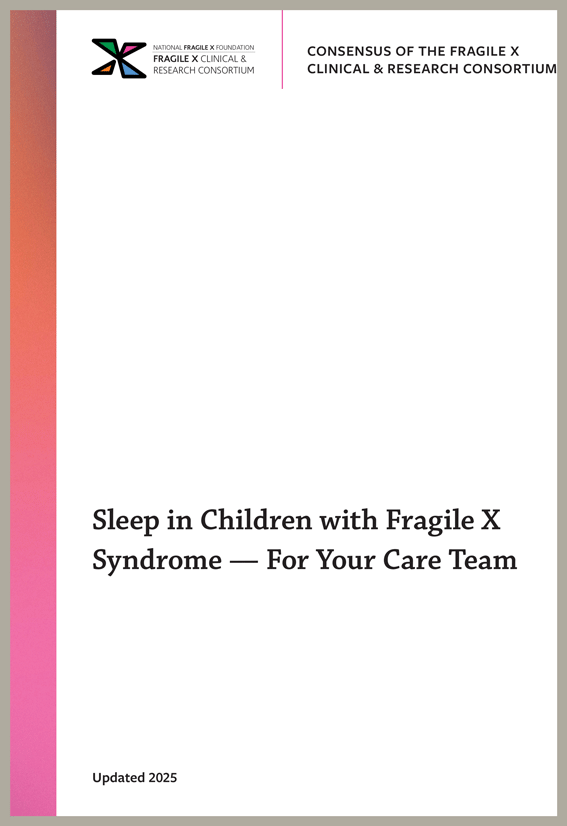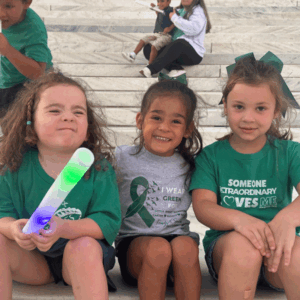Health experts frequently remind the general public about the mental and physical benefits of a good night’s sleep. However, surveys and research over the past years confirm that many children with Fragile X syndrome (FXS) experience problems with sleep and that these problems can last for many years.
These sleep problems or “sleep disturbances” can make caring for a child with FXS even more challenging, as parents and other caregivers deal with their own need for sleep. Fortunately, as professionals have better understood these sleep problems, interventions have been developed that can lessen their severity. These interventions include the use of medication, which is prescribed and monitored by doctors, and various other interventions that involve behavioral therapists and other non-medical specialists.
Parents can hope that their child’s sleep quality will improve over time. Some of that improvement will occur as a result of the typical techniques that all parents utilize (bedtime routines, nightlights, comfort and security items), but in the case of FXS, specialist intervention may be necessary.
Alternate Version
We also have a more technical version of our sleep recommendations, in which the authors provide detailed descriptions of sleep disturbances, analysis of current and past research related to those with FXS and other neurodevelopmental disorders (NDDs), and recommended interventions. Parents and other care providers may want to share both of these documents with their child’s doctor and others involved in day-to-day care.

Overview
It has been well-established that children with neurodevelopmental disorders such as FXS have higher rates of sleep disturbances than those in the general population.[1] Common sleep problems among children with FXS include difficulties with falling asleep, reduced sleep quality, shorter sleep duration, frequent nighttime awakenings, resistance at bedtime, and daytime sleepiness.[2] These sleep problems can coexist and persist across the lifespan.
According to parental reports, which included parents of 1,295 children with FXS, approximately one-third of them currently face sleep issues, and, among those, over 80% are dealing with at least two sleep problems simultaneously.[3] The most common difficulties reported in this study were trouble falling asleep and waking up frequently at night. Additionally, nearly half of the boys and a significant portion of the girls received at least one medication to aid their sleep. Children with more severe health or behavioral challenges were more likely to experience ongoing sleep problems, as in NDDs in general.[4] In another study, caregivers provided information on the sleep patterns of a group of 90 children with FXS using the Children’s Sleep Habits Questionnaire, along with a 14-day sleep diary.[5] The results showed that nearly half of the participants had sleep issues that suggested the need for further evaluation and referral.[6]
Profile of Sleep Problems in FXS
The most recent and most extensive analysis of sleep problems data, from the FORWARD research project (a CDC-funded multi-year effort to better understand how FXS presents itself over a person’s lifetime), examined the frequency, severity, and impact of sleep disorders among a group of young individuals with FXS.[7] The researchers found that many individuals with FXS experienced problems, with six of the seven surveyed having sleep difficulties. The seventh, sleep apnea, was found to be less prevalent. The six surveyed common sleep difficulties involved either sleep duration (difficulties falling asleep, frequent night-time awakenings) or sleep quality (morning tiredness, teeth grinding, bed wetting, restlessness).
While initial publications have indicated a lack of differences between males and females, the FORWARD survey found that, except for snoring, sleep problems affected predominantly young males.[8] In addition to sex and age, autistic symptoms are also a risk factor for sleep problems in FXS.[7] The 2017 FORWARD study of autism in FXS found that children and adolescents with FXS and autism had a higher frequency of sleep difficulties than those without ASD.[9]
Several publications have shown that, in terms of severity, sleep problems in children with FXS tend to be mild to moderate.[7] Nonetheless, the large FORWARD survey demonstrated that their impact is substantial, as demonstrated by the frequent use of medications for sleep (nearly half of individuals, especially males) and the strong association with behavioral problems, particularly irritability and aggression.[7] These findings suggest that a shorter night sleep was associated with increased daytime problem behaviors and greater parental stress.[10]
Sleep Apnea in Fragile X Syndrome
Obstructive sleep apnea (OSA) is a sleep disorder characterized by repeated episodes of partial or complete blockage of the upper airway during sleep.[11] OSA can be associated with various neurodevelopmental disorders.[12] The blockages can cause breathing to stop for short periods, leading to disrupted sleep patterns and a decrease in oxygen levels in the blood. While some signs and symptoms of sleep apnea can be similar in both children and adults, certain features are more commonly observed in children: loud and persistent snoring, breathing pauses, restless sleep, mouth breathing, sleeping in unusual positions, and more.
It is important to note that not all children with OSA will display all of these characteristics. Additionally, some children may not snore loudly, making identifying the condition more challenging. If parents or caregivers notice these signs or suspect their child may have OSA, it is crucial to consult a healthcare professional for proper evaluation and diagnosis.[13] Specifically, the recent FORWARD study found that, according to parental reports, approximately 8% of children with FXS had a history of OSA.[14] However, clinicians reported a lower prevalence of OSA, with only 3.4% of individuals affected. Notably, these figures for OSA frequency differ significantly from the 30% of children reported to have loud snoring.
Studies have revealed a strong link between sleep apnea, intense snoring, and an association between OSA and morning tiredness or frequent night-time awakenings. In other words, loud snoring, when severe, and usually in teenage boys, indicates a high risk for OSA.[7] These findings have important implications for the management of children with FXS, as OSA may be underdiagnosed, particularly in patients with more challenging behaviors. It’s worth considering that individuals with less severe snoring symptoms may still have OSA, especially if it presents as gasping rather than snoring.
Diagnosis of Sleep Difficulties
In line with advances in the field of pediatric sleep disorders, the diagnosis of sleep problems in individuals with NDDs has evolved from informal reports by caregivers to the use of standardized instruments.[14]
For detailed descriptions of the tools used to evaluate sleep disturbances, which you can print and share with your doctor or other care team members, we have a more technical alternate version of our sleep recommendations, in which the authors provide detailed descriptions of sleep disturbances, analysis of current and past research related to those with FXS and other neurodevelopmental disorders (NDDs), and recommended interventions. Parents and other care providers may want to share both of these documents with their child’s doctor and others involved in day-to-day care.

Impact of Sleep Problems: Behavioral Abnormalities and Quality of Life
Sleep problems in individuals with FXS can be a significant problem for caregivers. Sleep problems requiring treatment occur more frequently in adolescents and young adults with FXS and autism than in their counterparts without autism. In contrast, sleep problems requiring treatment occur with equal frequency in children with FXS with and without co-occurring autism.[15] A recent FORWARD investigation showed that sleep difficulties are associated with behavioral problems in individuals with FXS. Indeed, the presence of any of the sleep problems was more frequently associated with the occurrence of irritability and aggression. All sleep problems, except morning tiredness, were also associated with hyperactivity.[7] Self-injurious behavior in males with FXS has also been associated with a number of co-occurring conditions, including sleep problems.[16]
There is some data from other populations that behavior can improve with treatment of a sleep disorder. In a study using an extended-release preparation of melatonin, increases in sleep duration in children with autism were associated with improvements in behavior.[17] One study showed that treating obstructive sleep apnea in typically developing children improved behavior.[18]
Treatment of Sleep Problems in Fragile X Syndrome
The recommendations for treatments for sleep problems in children with FXS presented here are primarily based on treatment for sleep disorders in autism or NDDs in general.[19]
Non-Pharmacological Treatment
The initial approach to addressing sleep difficulties involves applying behavioral techniques (sleep hygiene). These include establishing regular sleep times, following consistent bedtime rituals, and using calming methods for both going to bed and waking up in the middle of the night.[20] Nonetheless, these techniques might not always be enough, and in some cases, using medication alongside these strategies could be necessary.
Pharmacological Treatment
If behavioral strategies alone are not effective, medications are suggested. Always consult with your child’s doctor before undertaking any treatment involving medication. Never use medications prescribed for a different individual.
See the section on sleep in Medications for Individuals with Fragile X Syndrome for more details about the pros and cons of each medication, dosages, and timing.
- Melatonin: Melatonin is the first-choice drug for sleep issues because it has the largest body of evidence. It is generally a safe option, although drowsiness, dizziness, headaches, and increased enuresis have been reported. Clinical trials have demonstrated that melatonin is effective for sleep-onset insomnia, increasing overall sleep time, but does not decrease nocturnal awakenings (maintenance insomnia).[21]
- Clonidine: If melatonin is ineffective, the most commonly used alternative is clonidine. It is available in multiple formulations, including extended-release and transdermal patches. It is worth noting that over time, effectiveness may diminish, potentially necessitating higher doses to achieve the same outcome. Clonidine appears to be effective for night waking, sleep latency, and sleep duration, and, because of its behavioral effects, it should be considered for children who also present with behavioral symptoms. Clonidine is, in general, well tolerated; its side effects include daytime drowsiness. If needed to be discontinued because of adverse effects or lack of effectiveness, clonidine should be reduced slowly over 2 to 7 days.[22]
- Trazodone: The antidepressant Trazodone can also be used at bedtime. Although typically well tolerated, trazodone might make individuals feel tired.[22]
- Other Drugs: Diphenhydramine and hydroxyzine are suggested for short-term use. Please note that some individuals may become hyperactive on diphenhydramine. In addition, hydroxyzine can be used for sleep and anxiety throughout the day. The recommended dose for these medications depends on age and weight. If all medications mentioned do not work, the antidepressant mirtazapine could be considered.[23] Side effects include increased appetite and body weight. Other alternative drugs include gabapentin, atypical antipsychotics (risperidone, quetiapine), and hypnotics (clonazepam, zolpidem, temazepam, suvorexant).[22]
Complementary and Alternative Interventions
These include massage therapy, aromatherapy, and weighted blankets. The few studies investigating these treatments do not support their usefulness, although the latter are well tolerated.[24]
Medications for Individuals with Fragile X Syndrome
Medications are, at times, helpful to facilitate the individual’s ability to attain optimal life skills and allow for better integration into educational, adult, and social environments.
Conclusions
Data from the FORWARD project and the literature support the notion that, as in other NDDs, sleep problems are frequent and impactful in FXS. These findings emphasize the need for early diagnosis and tailored interventions in groups who are particularly at high risk, namely young children, males, and those with severe autistic behavior. Accurate diagnosis of sleep problems in FXS requires incorporating specialized tools, such as standardized questionnaires. For those concerned about sleep apnea, a referral to a center performing a sleep apnea test, called a polysomnogram (PSG), is encouraged. This may be done in a sleep disorder center or even at home.
 Note: As previously noted, a more technical, descriptive, and detailed version of this treatment recommendation is available. It was also written by medical experts within (and reviewed by) the National Fragile X Foundation’s Fragile X Clinical & Research Consortium.
Note: As previously noted, a more technical, descriptive, and detailed version of this treatment recommendation is available. It was also written by medical experts within (and reviewed by) the National Fragile X Foundation’s Fragile X Clinical & Research Consortium.


